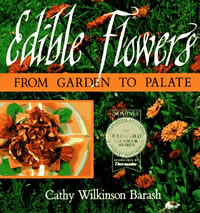I am planning to decorate my wedding cake with Alstroemeria. Are these flowers safe to use? The flowers won’t be eaten, but will be in contact with the icing.
The website of National Sustainable Agriculture Information Service has a page of resources on edible flowers, including links to information about toxic plants. Alstroemeria can cause contact dermatitis when handled, and ingesting the plant can cause gastrointestinal problems. See the following information on Alstroemeria from North Carolina State University Extension.
Rather than take any chances, I recommend restricting your decoration choices to
edible flowers. A mixture of calendula, lavender, and violet blossoms, for
example, might be an attractive option. North Carolina State University Extension also has an article on edible flowers.
Iowa State University Extension has useful guidelines on selecting edible flowers.
Are Magnolia flowers edible?
Buds, flowers, and leaves in various stages of growth have edible uses. According to the Plants for a Future database, “The flowers [of Magnolia grandiflora] are pickled in some parts of England and are considered to have an exquisite flavor. They are also said to be used as a spice and a condiment.” Cornucopia II by Stephen Facciola (Kampong Publications, 1998) confirms this and also says that the flowerbuds of Magnolia denudata are used in Asian cuisine. After removing the calyxes, the buds are pickled and used to flavor rice, and to scent tea. In Japan, the young leaves and flower buds of Magnolia hypoleuca are broiled and eaten as a vegetable. Older leaves are made into a powder and used as seasoning; dried, whole leaves are placed on a charcoal brazier and filled with miso, leeks, daikon, and shiitake, and broiled. There is a type of miso which is seasoned with Magnolia, hoba miso.
Condensed rules for eating flowers:
- Only eat flowers that are positively identified to be edible.
- Not all flowers are edible, even some served as a garnish in restaurants.
- Do not eat flowers that may have been sprayed with pesticides, such as from a florist, nursery, or from the side of a road.
- Eat only petals, not pistils and stamens.
- If you suffer from asthma or allergies be cautious when eating flowers.
 What could be more satisfying than creating a meal with home-grown edible flowers? Author Cathy Wilkinson Barash, in her book Edible Flowers: From Garden to Palate (Fulcrum, 1995) tempts the reader with sweet and savory recipes that feature fresh flowers. Barash goes far beyond a mere sprinkling of nasturtiums in a summer salad to include recipes for lilac chicken, bee balm ice cream and dandelion eggs. For each flower featured the descriptions include botanical, historical and growing information plus color photos of the plant and many of the recipes. The last chapter is perhaps most important because it gives the “ten rules of edible flowers,” explaining precautions that must be taken before a person starts eating flowers.
What could be more satisfying than creating a meal with home-grown edible flowers? Author Cathy Wilkinson Barash, in her book Edible Flowers: From Garden to Palate (Fulcrum, 1995) tempts the reader with sweet and savory recipes that feature fresh flowers. Barash goes far beyond a mere sprinkling of nasturtiums in a summer salad to include recipes for lilac chicken, bee balm ice cream and dandelion eggs. For each flower featured the descriptions include botanical, historical and growing information plus color photos of the plant and many of the recipes. The last chapter is perhaps most important because it gives the “ten rules of edible flowers,” explaining precautions that must be taken before a person starts eating flowers.
 What could be more satisfying than creating a meal with home-grown edible flowers? Author Cathy Wilkinson Barash, in her book Edible Flowers: From Garden to Palate (Fulcrum, 1995) tempts the reader with sweet and savory recipes that feature fresh flowers. Barash goes far beyond a mere sprinkling of nasturtiums in a summer salad to include recipes for lilac chicken, bee balm ice cream and dandelion eggs. For each flower featured the descriptions include botanical, historical and growing information plus color photos of the plant and many of the recipes. The last chapter is perhaps most important because it gives the “ten rules of edible flowers,” explaining precautions that must be taken before a person starts eating flowers.
What could be more satisfying than creating a meal with home-grown edible flowers? Author Cathy Wilkinson Barash, in her book Edible Flowers: From Garden to Palate (Fulcrum, 1995) tempts the reader with sweet and savory recipes that feature fresh flowers. Barash goes far beyond a mere sprinkling of nasturtiums in a summer salad to include recipes for lilac chicken, bee balm ice cream and dandelion eggs. For each flower featured the descriptions include botanical, historical and growing information plus color photos of the plant and many of the recipes. The last chapter is perhaps most important because it gives the “ten rules of edible flowers,” explaining precautions that must be taken before a person starts eating flowers.